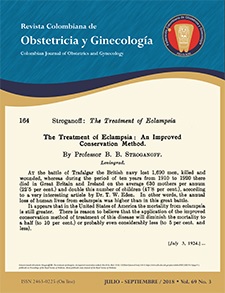Inferior vena cava thrombosis in term pregnancy: Case report and review of the literature
DOI:
https://doi.org/10.18597/rcog.3011Keywords:
Therapeutics, vein thrombosis, inferior vena cava, pregnancyAbstract
Objective: To conduct a review of the published literature on the treatment of inferior vena cava thrombosis in pregnancy.
Materials and methods: Case description of inferior vena cava thrombosis in a woman with term pregnancy coming to a private level IV referral centre. It was initially managed with low-molecular weight heparin, which was discontinued 24 hours before delivery. Although the perinatal outcome was good, the patient developed postpartum bleeding and perineal haematoma. Endovascular treatment for thrombolysis and attempted thrombectomy was performed later. A review of the literature was conducted using the terms “inferior vena cava”, “vena cava filters”, “thrombosis” and “pregnancy”. Case reports and case series in English and Spanish were included. All the cases describing the treatment used in women with vena cava thrombosis diagnosed during pregnancy or the postpartum period were selected.
Results: Overall, 17 publications that met the search criteria were included, and 41 cases were identified: 35 patients were diagnosed with inferior vena cava thrombosis during pregnancy and 6 were identified during the postpartum period. Low molecular weight heparin or unfractionated heparin was used for anticoagulation in 100 % of the patients; 34 pregnant women required inferior vena cava filter for peripartum management, and only one patient needed thrombectomy.
Conclusion: Peripartum inferior vena cava thrombosis is challenging from the therapeutic point of view. There is a need to balance the risk of pulmonary thromboembolism and massive bleeding. Adequate coordination between the different services involved is mandatory in order to ensure maximum safety and avoid complications.Author Biographies
María Fernanda Escobar-Vidarte
Unidad de alta complejidad obstétrica, Departamento de Ginecología y obstetricia, Fundación Valle del Lili, Cali (Colombia).
Sara del Pilar Loaiza-Osorio
Centro de investigaciones clínicas, Fundación Valle del Lili, Cali
(Colombia). saraloaiza1@gmail.com
Albaro José Nieto-Calvache
Unidad de alta complejidad obstétrica, Departamento de Ginecología y obstetricia, Fundación Valle del Lili, Cali (Colombia).
References
Marik PE, Plante LA. Venous thromboembolic disease and pregnancy. N Engl J Med. 2008;359:2025-33. https://doi.org/10.1056/NEJMra0707993
Bourjeily G, Paidas M, Khalil H, Rosene-Montella K, Rodger M. Pulmonary embolism in pregnancy. The Lancet. 2010;375:500-12. https://doi.org/10.1016/S0140-6736(09)60996-X
Middeldorp S. Thrombosis in women: What are the knowledge gaps in 2013? J Thromb Haemost (JTH). 2013;11 Suppl 1:180-91. https://doi.org/10.1111/jth.12266
Stein PD, Beemath A, Matta F, Weg JG, Yusen RD, Hales CA, et al. Clinical characteristics of patients with acute pulmonar y embolism: Data from PIOPED II. Am J Med. 2007;120:871-9. https://doi.org/10.1016/j.amjmed.2007.03.024.
Heit JA, et al. Trends in the incidence of venous thromboembolism during pregnancy or postpartum: A 30-year population-based study. Ann Intern Med. 2005;143:697-706. https://doi.org/10.7326/0003-4819-143-10-200511150-00006.
Pomp ER, Lenselink AM, Rosendaal FR, Doggen CJM. Pregnancy, the postpartum period and prothrombotic defects: Risk of venous thrombosis in the MEGA study. J Thromb Haemost JTH. 2008;6:632-7. https://doi.org/10.1111/j.1538-7836.2008.02921.x.
Jacobsen AF, Skjeldestad FE, Sandset PM. Incidence and risk patterns of venous thromboembolism in pregnancy and puerperium—a register-based case— control study. Am J Obstet Gynecol. 2008;198:233.e1-7. https://doi.org/10.1016/j.ajog.2007.08.041.
Rosenberg VA, Lockwood CJ. Thromboembolism in pregnancy. Obstet Gynecol Clin North Am. 2007;34:481-500, xi. https://doi.org/10.1016/j.ogc.2007.06.006.
Nelson SM, Greer IA. Thrombophilia and the risk for venous thromboembolism during pregnancy, delivery, and puerperium. Obstet Gynecol Clin North Am. 2006;33:413-27. https://doi.org/10.1016/j.ogc.2006.05.009.
Doyle NM, Monga M. Thromboembolic disease in pregnancy. Obstet Gynecol Clin North Am. 2004;31:319-44, vi. https://doi.org/10.1016/j.ogc.2004.03.008.
Gherman RB, Goodwin TM, Leung B, Byrne JD, Hethumumi R, Montoro M. Incidence, clinical characteristics, and timing of objectively diagnosed venous thromboembolism during pregnancy. Obstet Gynecol. 1999;94(5 Pt 1):730-4. https://doi.org/10.1097/00006250-199911000-00017.
Ginsberg JS, Hirtsh J. Use of antithrombotic agents during pregnancy. Chest 1995;108:suppl: 305S-11S. https://doi.org/10.1378/chest.108.4_Supplement.305S.
Ferrer MF, Oyarzun EE. Trombosis venosa en el embarazo. Revista médica Clínica las Condes. 2014;25:1004-18. https://doi.org/10.1016/S0716-8640(14)70650-9
Hirsh J. Heparin. N Engl J Med. 1991;324:1565-74. https://doi.org/10.1056/NEJM199105303242206.
Ginsberg JS, Bates SM. Management of venous thromboembolism during pregnancy. J Thromb Haemost. 2003;1:1435-42. https://doi.org/10.1046/j.1538-7836.2003.00307.x.
How to Cite
Downloads
Downloads
Published
Issue
Section
License
Copyright (c) 2018 Revista Colombiana de Obstetricia y Ginecología

This work is licensed under a Creative Commons Attribution-NonCommercial-NoDerivatives 4.0 International License.
| Article metrics | |
|---|---|
| Abstract views | |
| Galley vies | |
| PDF Views | |
| HTML views | |
| Other views | |
















